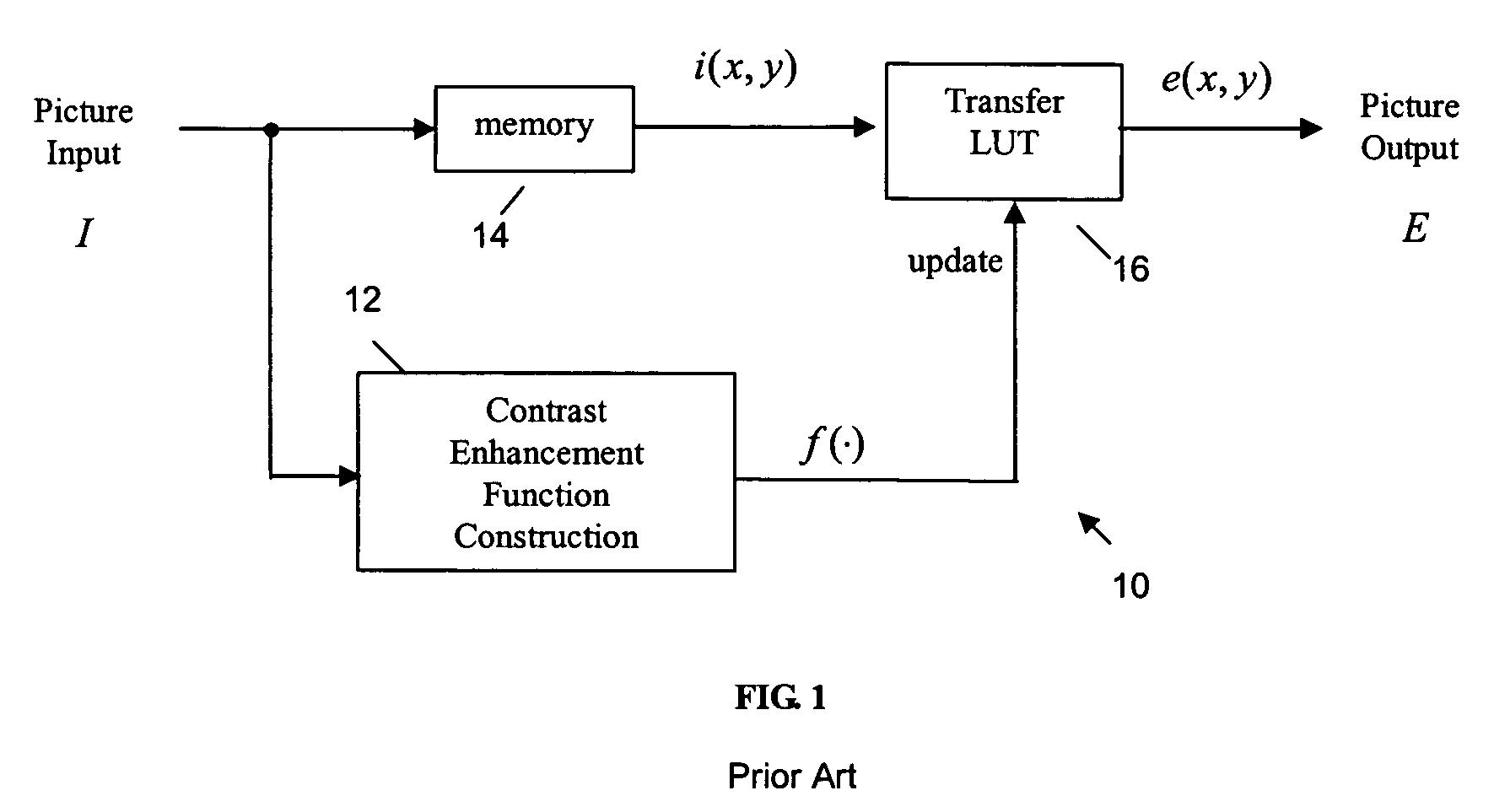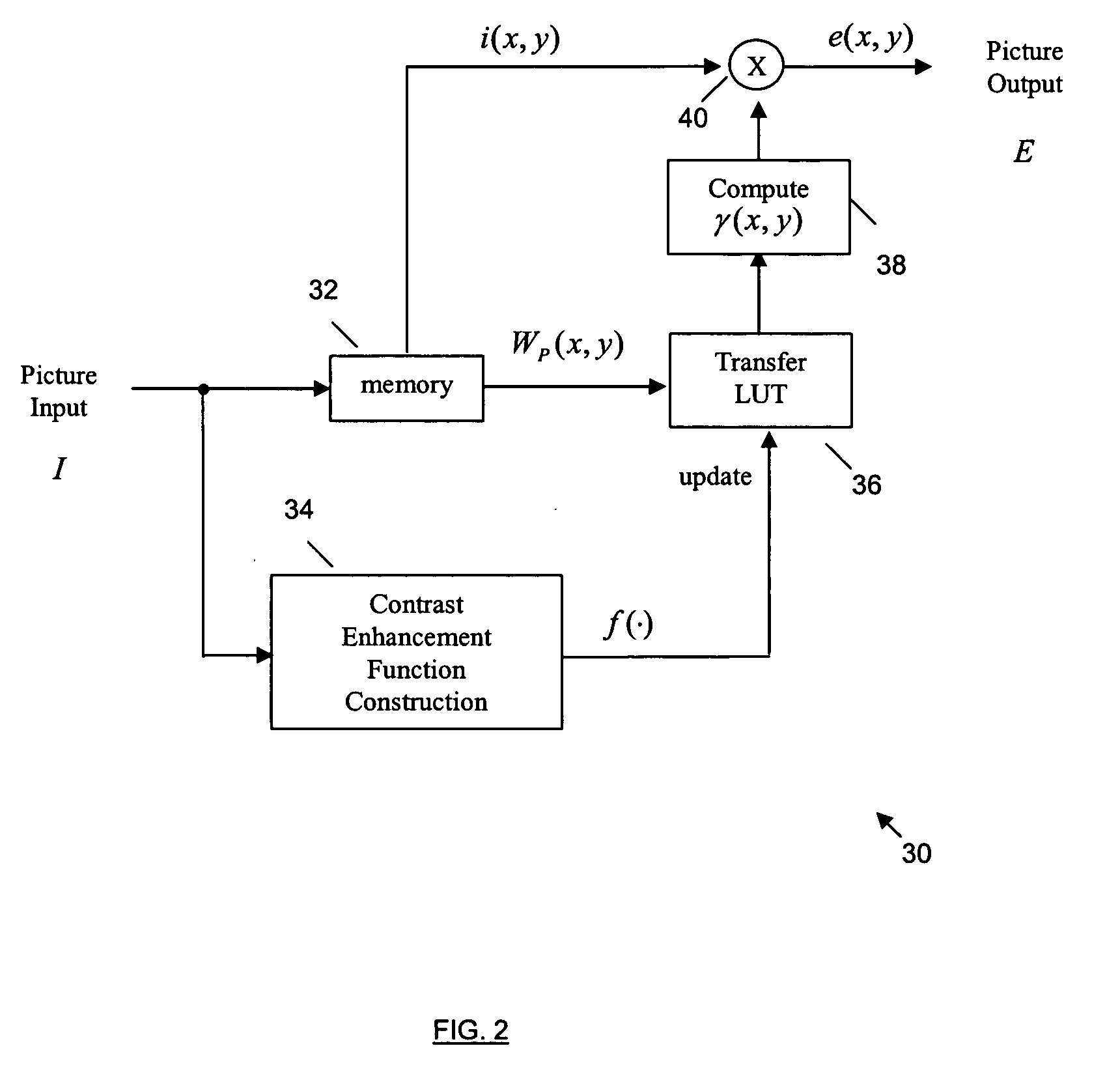Methods of preventing noise boost in image contrast enhancement
a technology of image contrast and noise reduction, applied in image enhancement, image analysis, instruments, etc., can solve the problems of image noise, difficult to quantify the criteria of enhancement, and only enhance the video quality of digital video systems, so as to improve the contrast of digital pictures and reduce noise amplification
- Summary
- Abstract
- Description
- Claims
- Application Information
AI Technical Summary
Benefits of technology
Problems solved by technology
Method used
Image
Examples
first example implementation
[0030] In one example implementation, given a contrast enhancement function (i.e., transform function) f, an average transform ratio γ is determined as: γ(x,y)=∑i=1Pf(wi(x,y))wi(x,y)·1P(3)
wherein ƒ(wi(x, y)) is the output of the contrast enhancement function f for input samples wi(x, y), such that f(wi(x,y))wi(x,y)
represents the transform ratio for a sample wi(x, y). Hence γ provides the average transform ratio, f(wi(x,y))wi(x,y),
around the sample I (x, y).
[0031] The value of γ changes slowly across the input picture because of the low-pass nature of the averaging function in relation (3) above. As such, in an enhancement method according to the present invention, for a sample in the input picture, the neighboring samples have the same or similar transform ratio.
[0032] Accordingly, an example of suppressing noise amplification while enhancing the contrast is provided by:
e(x, y)=γ(x, y)·i(x, y) (4)
for all x=1, 2, . . . , N and y=1, 2, . . . , M
second example implementation
[0033] In another example implementation, given a contrast enhancement function (i.e., transform function) f, the transform ratio γ is determined as: γ(x,y)=∑i=1Pf(wi(x,y))wi(x,y)·ci(5)
where ci are pre-determined constants satisfying ∑i=1Pci=1,
and
e(x, y)=γ(x, y)·i(x, y) (6)
for all x=1, 2, . . . , N and y=1, 2, . . . , M
[0034] Note that relation (5) above is a generalized version of relation (3) above. By selectively adjusting the values of ci, versatile suppression characteristics can be realized.
third example implementation
[0035] In another example implementation, the transform ratio γ is determined as: γ(x,y)=∑i=1Pf(wi(x,y))wi(x,y)·δ(i(x,y)-wi(x,y))∑i=1Pδ(i(x,y)-wi(x,y))(7)
[0036] where
E(x, y)=γ(x, y)·i(x, y) (8)
for all x=1, 2, . . . , N and y=1, 2, . . . , M , wherein δ(|i(x, y)−wi(x, y)|) is a weighting function of |i(x, y)−wi(x, y)|, which can be defined in different forms depending on application. One example constraint on the weighting function is that δ(|i(x, y)−wi(x, y)|) approaches 0 as the value of |i(x, y)−wi(x, y)| increases, and δ(|i(x, y)−w,(x, y)|) approaches 1 as the value of |i(x, y)−wi(x, y)| decreases to 0.
[0037] An example of δ(|i(x, y)−wi(x, y)|) satisfying such constraint can be: δ(i(x,y)-wi(x,y))={1-i(x,y)-wi(x,y)K,if i(x,y)-wi(x,y)≤K0else.(9)
[0038] The role of the weighting function is to take the transform ratios of the samples whose pixel values are close to i(x, y), into computation. In other words, if the pixel value of a neighboring pixel (wi...
PUM
 Login to View More
Login to View More Abstract
Description
Claims
Application Information
 Login to View More
Login to View More - R&D
- Intellectual Property
- Life Sciences
- Materials
- Tech Scout
- Unparalleled Data Quality
- Higher Quality Content
- 60% Fewer Hallucinations
Browse by: Latest US Patents, China's latest patents, Technical Efficacy Thesaurus, Application Domain, Technology Topic, Popular Technical Reports.
© 2025 PatSnap. All rights reserved.Legal|Privacy policy|Modern Slavery Act Transparency Statement|Sitemap|About US| Contact US: help@patsnap.com



